#Standalone Data Visualization Tools
Explore tagged Tumblr posts
Text
How Shopify Schema Generator setup can Help Your Shopify Store Get Seen

In the bustling world of e-commerce, standing out from the competition requires more than just a visually appealing website. To ensure your Shopify store gains the visibility it deserves, integrating a Shopify Schema Generator can be a game-changer. This powerful tool can enhance your search engine optimization (SEO) efforts, ensuring your products and services are easily discoverable by potential customers. This comprehensive guide will delve into the nuances of the Shopify Schema Generator and how it can elevate your store’s presence online.
Understanding Shopify Schema
Before diving into the specifics of the Shopify Schema Generator, it’s essential to understand what schema is. Schema markup, a form of microdata, helps search engines understand the content on your website. By adding this code to your Shopify store, you enable search engines to provide more informative results to users. This can include enhanced snippets, such as product prices, availability, and reviews, directly in search engine results pages (SERPs).
The Importance of Schema Markup for Shopify Stores
The benefits of implementing schema markup in your Shopify store are manifold:
Improved Visibility: Enhanced listings in SERPs can significantly increase your click-through rates.
Better SEO Performance: Search engines like Google prioritize websites with structured data, leading to better rankings.
Increased Credibility: Providing more information directly in search results builds trust with potential customers.
How the Shopify Schema Generator Works
The Shopify Schema Generator simplifies the process of adding schema markup to your store. This tool generates the necessary code snippets that can be easily integrated into your Shopify theme, ensuring your store complies with schema standards.
Key Features of the Shopify Schema Generator
Ease of Use: The generator provides an intuitive interface, allowing users to create schema markup without needing extensive coding knowledge.
Comprehensive Schema Types: Support for various Shopify Schema Types ensures that all aspects of your store, from products to services, are covered.
Customization Options: Tailor the schema markup to match your specific needs, enhancing the relevance of the data provided to search engines.
Setting Up the Shopify Schema Generator
To harness the full potential of the Shopify Schema Generator, follow these steps:
Access the Generator: Most generators can be found as standalone tools or integrated within specific Shopify apps.
Select Schema Types: Choose the appropriate Shopify Schema Types for your store, such as product, review, or local business schema.
Generate Code: The generator will provide the necessary code snippets based on your selections.
Integrate with Shopify: Add the generated code to your Shopify theme, typically within the theme.liquid file or specific template files.
Optimizing Schema Markup for Better Results
While the Shopify Schema Generator provides a solid foundation, further optimization can enhance its effectiveness. Here are some tips:
Regular Updates: Ensure your schema markup is updated regularly to reflect changes in your products or services.
Utilize Presets in Shopify: Leveraging presets in Shopify can streamline the process of maintaining consistent schema markup across your store.
Monitor Performance: Use tools like Google Search Console to monitor how your schema markup is performing and make adjustments as needed.
The Role of Top Shopify Agencies and Shopify Management Services
Partnering with experts can amplify the benefits of using a Shopify Schema Generator. Top Shopify agencies and Shopify management services can provide valuable insights and assistance, ensuring your schema markup is optimized for maximum impact.
Choosing the Right Shopify Agency
When selecting an agency, consider the following:
Experience: Look for agencies with a proven track record in Shopify SEO and schema markup implementation.
Customization: Ensure the agency can tailor solutions to fit your unique business needs.
Support: Ongoing support and monitoring are crucial for maintaining and improving your schema markup strategy.
Shopify Schema for Various Business Models
The Shopify Schema Generator is versatile and can benefit different types of Shopify stores, including:
Shopify One Product Store: Highlight your single product’s features, reviews, and availability to attract more attention in search results.
Shopify Service Business: Enhance your service listings with detailed schema markup, showcasing customer reviews and service descriptions.
Shopify Plus Designers: Schema markup can be customized to highlight premium features and services offered by Shopify Plus designers.

Enhancing Your Store’s Aesthetics with Shopify Color Schemes
While schema markup focuses on SEO, the visual appeal of your store should not be neglected. Utilizing Shopify color schemes can enhance the user experience, making your store more attractive and engaging.
Tips for Choosing the Right Color Scheme
Brand Consistency: Ensure the colors align with your brand identity.
User Experience: Select colors that enhance readability and navigation.
Emotional Impact: Consider the psychological effects of colors on your target audience.
The Technical Side: Shopify System Requirements
Ensuring your store meets the Shopify system requirements is crucial for optimal performance and compatibility with schema markup.
Key Requirements
Updated Browser: Use the latest versions of browsers for compatibility with Shopify features and tools.
Reliable Hosting: Ensure your hosting plan supports the traffic and data demands of your store.
Performance Optimization: Regularly monitor and optimize your store’s performance to ensure quick loading times and a smooth user experience.
Shopify App Development Company: Leveraging Custom Solutions
Partnering with a Shopify app development company can provide custom solutions to enhance your schema markup strategy. These companies can develop apps that integrate seamlessly with your store, offering advanced features and automation.
Benefits of Custom Apps
Enhanced Functionality: Custom apps can provide features not available in standard Shopify apps.
Automation: Automate repetitive tasks, allowing you to focus on strategic aspects of your business.
Scalability: Custom apps can be tailored to grow with your business, ensuring long-term viability.
Cincinnati Ecommerce Website Design: A Local Perspective
For businesses in Cincinnati, working with a Cincinnati ecommerce website design firm can provide localized expertise and support. These firms understand the local market dynamics and can tailor solutions to meet specific regional needs.
The Benefit of Shopify Plus
Upgrading to Shopify Plus offers numerous advantages, particularly in terms of scalability and customization.
Key Benefits
Advanced Features: Access to exclusive features and tools designed for high-volume merchants.
Customization: Greater flexibility in customizing your store to meet unique business requirements.
Support: Dedicated support from Shopify Plus experts, ensuring any issues are promptly resolved.
HubOps: Your Partner in E-commerce Success
At HubOps, we specialize in providing comprehensive Shopify management services, including schema markup implementation, SEO optimization, and custom app development. Our team of experts is dedicated to helping your store achieve its full potential, ensuring you stand out in the competitive e-commerce landscape.
Conclusion
Integrating a Shopify Schema Generator into your e-commerce strategy can significantly enhance your store’s visibility and performance. By understanding the intricacies of schema markup and leveraging the right tools and expertise, you can ensure your Shopify store attracts and retains more customers. Whether you’re a small Shopify one product store or a large enterprise utilizing Shopify Plus, schema markup can provide the edge you need to succeed.
For more information on how HubOps can assist with your Shopify schema setup and other e-commerce needs, contact us today. Our team is ready to help you navigate the complexities of e-commerce and achieve your business goals.
By leveraging the Shopify Schema Generator, you can transform your Shopify store into a powerhouse of SEO and user engagement. Start optimizing today and watch your store’s visibility soar.
#Shopify Schema Generator#shopify dropshipping#shopify development company#shopify website#shopify development#shopify#ecommerce#shopify agency in cincinnati#shopify agency in Ohio#shopify agency in USA#shopify agency#Best shopify agency
2 notes
·
View notes
Text

F/A-18’s Infrared Search And Track System Plagued By Delays
Manufacturing quality issues and testing delays mean that the Navy is still waiting for its much-needed infrared search and track pods.
Thomas NewdickPUBLISHED Jun 9, 2023 2:28 PM EDT
F/A-18F IRST POD
U.S. Air Force photo by Staff Sgt. James Merriman)
The U.S. Navy’s Infrared Search And Track System, or IRST, intended for its F/A-18E/F Super Hornet fighter jets, is still to join the fleet, more than four years after it entered production. The podded IRST, seen as a critical tool to retain the Navy’s air-to-air advantage over potential adversaries, was first flown on a Super Hornet in late 2019, but operational testing is not now expected to begin until early next year.
The U.S. Government Accountability Office (GAO), in its latest Report to Congressional Committees, provides an update on the status of the IRST pod, which is still dogged by production quality issues and which officials worry could be subject to more delays in the future. All this is happening at a time when an IRST capability is arguably more important than ever.

A Lockheed Martin infographic showing different applications for its IRST2 1 sensor, including the podded version for the Navy F/A-18E/F Super Hornet. Lockheed Martin
In the past, we have looked extensively at the advantages an IRST pod will bring to the Super Hornet community and the Navy’s tactical aviation branch as a whole.
To summarize, an IRST sensor is entirely passive, using the infrared spectrum alone to detect and track airborne targets, including those at far beyond visual range. With no radio-frequency emissions, the target won’t be alerted to the fact that they’ve been detected and are being tracked.
As stealth technology and advanced electronic warfare capabilities continue to proliferate, the arguments behind introducing an IRST become even more compelling. By their nature, IRST sensors are immune to electromagnetic jamming and other electronic attacks and can literally see through radar-evading stealth technology.

IRST21 built into the centerline tank on the Super Hornet during tests. U.S. Navy
As well as operating as a standalone sensor, an IRST can furthermore make use of sensor-fusion capabilities, adding a critical sensor data stream to enhance a flight crew’s situational air-to-air ‘picture’ in conjunction with more traditional sensors.
The Super Hornet’s IRST — which is installed in the nose of an external fuel tank — is clearly a big deal and an item that is only becoming more essential as potential foes like China and Russia expand their stealth and electronic warfare capabilities.
Some iteration of the pod has also been deployed on operations, carried by Super Hornets in the Middle East, with photos emerging of this in late 2020. The results of these combat trials remain unknown, and it’s not clear to what degree the pods used were actually functional, but it was a significant step to test them in this way, regardless.

Equipped with an IRST pod, a U.S. Navy F/A-18F flies over the U.S. Central Command area of responsibility during a mission in support of Operation Inherent Resolve, September 30, 2020. U.S. Air Force photo by Staff Sgt. James Merriman
So why, exactly, is the Navy having to wait so long for its IRST pod?
According to officials, “between 20 and 30 percent of the manufactured components [in the IRST pod] failed to meet performance specifications due to microelectronics issues.” More worrying still is the fact that these issues are persisting more than four years after limited manufacturing started and they are continuing to push back the launch of developmental and operational testing, as well as full-rate production.
It appears that the components affected were fiber-optic gyroscopes, considered “critical to delivering IRST capability.” To address the problem, the Navy is now meeting with manufacturer Lockheed Martin on a biweekly basis, “in an effort to improve manufacturing efficiency to support the planned rate of production.”
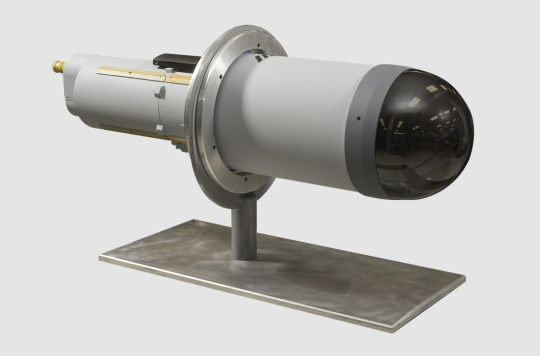
The Lockheed Martin IRST21 sensor, as used in the Navy Super Hornet IRST pod. Lockheed Martin
In more positive news, however, the same report does note that the program has “matured its one critical technology and has a stable design.”
But that won’t be much comfort for the Navy tactical aviation community who clearly want to get their hands on what is a potentially game-changing air combat tool.
Exactly when production IRST pods might start to reach the fleet is also unclear at this point. In January this year, the Navy received its first Block II production representative articles — known as infrared optimized configuration (IROC) pods. That was a full 10 months later than had been anticipated as of last year.

A conceptual diagram of how the IRST21 sensor is mounted in the fuel tank for the Super Hornet. Lockheed Martin
Once the IROC pods became available, the Navy was able to begin developmental testing, to verify that the system’s design meets all technical specifications and that all contract requirements have been met. Developmental testing is the precursor to operational testing, in which the IRST pod will be evaluated in an operational environment, and procedures and tactics developed for its use.
Completion of developmental testing is reliant upon sufficient pods being delivered, but officials are confident this will be achieved, to enable the start of operational testing in two locations in April 2024. That major milestone, if met, will be 44 months later than planned under the previous schedule.
The delays related to the launch of full-rate production also make for sobering reading. Due to the production quality issues and delays in operational testing, the full-rate production decision has been pushed back by 33 months.
To mitigate that, and keep the production line running to some degree, a seventh low-rate initial production (LRIP) lot has been added, and it may also be followed by an eighth. In the process, the number of pods acquired under the LRIP could leap to 73 — around 43 percent of the total quantity planned. However, until production quality issues are ironed out, there’s little option other than to extend the LRIP phase. The production line needs to be kept active, but at the same time, it’s too risky to move straight into full-rate production if more design changes are needed.

A render of Block III Super Hornets equipped with IRSTs. Boeing
Other factors that have led to holdups in the program include “staffing challenges” at a critical software development contractor, and delays in the delivery of hardware, which has had a knock-on effect on software development. This meant that, by August 2022, less than half of the total software development effort had been completed. In October last year, six new software releases arrived, but, as the report warns, “significant development and testing of functionality, maintenance, and security features remains to be completed.”
However, with the delivery of the first IROC pods, the hardware issue is now considered resolved, at least until the operational testing phase.
Last year, delays with the IRST pod were already bad enough that the program was deemed to have breached its baseline schedule and a risk assessment was launched to help get it back on track.
The risk assessment led to the Navy approving a revised schedule in May 2022, which included delaying the start of operational testing by 36 months to August 2023. Of course, that has now slipped further still, until April 2024. Program officials have said there could be more delays on top of that, as well, depending on progress with software development and flight testing.

F/A-18F equipped with an IRST. Lockheed Martin
All these delays not only mean that the IRST’s long-awaited capabilities are yet to be fielded by the Navy but also push up program costs.
According to the GAO, the estimated procurement costs have risen by about 12 percent, with inflation and global supply chain disruptions also having an effect here.
Furthermore, the delays mean that the planned service life of the IRST pods has also taken a dramatic hit. Not only will they arrive far later than planned, but they will become surplus to requirements more quickly, once the Super Hornet’s successor has begun to be fielded, planned for the 2030s. The anticipated net result is a 44 percent decrease in the planned service life of the pods. While a reduced service life would also bring down operation and support costs, the saving is expected to be only 33 percent, since upfront costs for support equipment, training aids, and initial spare parts will still need to be covered.

An artist’s conception of a sixth-generation stealth combat jet for the U.S. Navy, as well as an advanced companion drone design. Boeing
The program office responsible for the IRST pod has meanwhile taken other actions to try and improve the situation. These include building in 45 days of schedule margin prior to operational testing and making more use of commercial aircraft to support testing.
Efforts have also been made to increase synergies between the Navy’s IRST pod and a similar pod ordered for the Air National Guard. In this way, the program office says it’s reduced unit cost between the fourth and seventh LRIP lots by 29 percent. It does, however, beg the question as to why this path wasn’t taken to start with.
Speaking to The War Zone back in 2020, Capt. Jason Denney, head of the Super Hornet and Growler program for the U.S. Navy, explained some of the differences between the Lockheed Marin IRST set-up used by the Navy and that for the Air Force:
“We haven’t done anything specifically, co-development-wise with the Air Force. There are certain [common] aspects of the IRST, what they’re developing and ours. So, with the hardware modifications, things like that, we’ve kept a lot of those common, and commonality helps us when it comes down to configuration management or being able to buy huge blocks of them. If we all had, say, the same circuit card, for example, then, hey, we combine the Air Force and the Navy buys and then we all get a better price for it. But other than that, we really haven’t done a whole lot of close coordination because their requirements and their implementation are very different than ours.”
youtube
Meanwhile, we are not aware of any significant issues encountered with the Air Force versions of the Lockheed Martin IRST, although this cannot be ruled out.
All in all, the slow progress made by the Navy’s IRST pod program is clearly a concern for the service. While the Navy may already be quietly at work on a sixth-generation successor to the Super Hornet, the fact remains that the fourth-generation jet remains the backbone of the carrier air wing and will continue to do so for years to come.
It’s also worth noting that even the contractor-operated adversary community is flying jets with IRST sensors, with Tactical Air Support announcing that it had completed initial flight testing of the Lockheed Martin-designed TacIRST, an integrated IRST sensor, on its F-5 Advanced Tiger aggressor jets late last year. While there is a capability gap between the staring-type, fixed-senor TacIRST, and the full-spec Navy system, if Lockheed Martin is able to work with Tactical Air Support to bring this capability to the threat-replication community, it begs the question of why things have been so much more difficult with the Navy.

A zoomed-in shot of an F-5AT flight testing the TacIRST. The forward-staring device can be seen directly in front of the cockpit windscreen. TacAir
Many potential real-world adversaries of the United States are already regularly flying with internal IRST systems, including most Russian-made high-end fighter jets, such as the Su-35 and Su-30 Flanker series, also operated by China.

A Russian Su-35S with its IRST sensor on the right side of its nose in front of the windscreen. Russian Ministry of Defense
Delays in giving the Super Hornet a type of sensor that has already been deployed on many other fourth-generation platforms (as well having been retrofitted on Air Force F-15Cs and F-16Cs) is a serious issue, especially as low-observable threats are only going to proliferate and electronic warfare capabilities become an even bigger concern than they are now.
Contact the author: [email protected]
3 notes
·
View notes
Text
Medical Image Analysis Software Market Business Landscape Changes and Market Growth Patterns
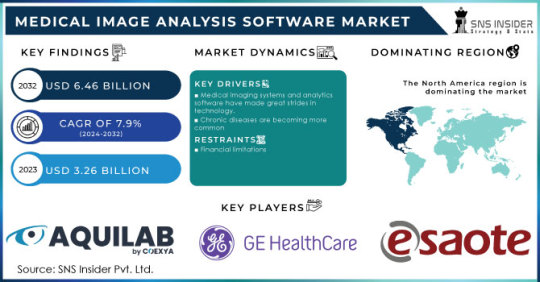
The global medical image analysis software market is projected to experience substantial growth in the coming years, driven by technological advancements, the growing demand for improved diagnostics, and an increased focus on precision medicine. The market is forecasted to expand due to the rapid integration of artificial intelligence (AI) and machine learning (ML) technologies in medical imaging, which are enhancing diagnostic accuracy and improving patient outcomes.
Market Overview
Medical image analysis software refers to applications that process and analyze medical images (such as X-rays, MRIs, and CT scans) to assist healthcare professionals in diagnosing diseases, monitoring treatment progress, and conducting medical research. These tools play a critical role in clinical decision-making, ensuring better accuracy and reducing human error. The market for these software solutions is expanding as healthcare professionals seek innovative ways to manage and interpret vast volumes of imaging data.
Get Free Sample Report @ https://www.snsinsider.com/sample-request/2198
Market Segmentation
The medical image analysis software market is segmented based on the following categories:
By Type
Standalone Software
Integrated Software
By Application
Oncology
Neurology
Cardiology
Orthopedics
Others
By Deployment
Cloud-based
On-premise
By End-User
Hospitals
Diagnostic Centers
Research Institutions
Others
Regional Analysis
The global medical image analysis software market spans across key regions, including:
North America: Dominating the market, driven by advanced healthcare infrastructure, high adoption of AI technologies, and an aging population requiring diagnostic imaging.
Europe: Following North America, with significant contributions from countries like Germany, the UK, and France. Increased research investments in medical imaging technologies and growing awareness among healthcare providers contribute to regional growth.
Asia-Pacific: Witnessing rapid adoption of healthcare technologies, particularly in countries like Japan, China, and India. The rising prevalence of chronic diseases and demand for efficient healthcare services are key drivers.
Latin America & Middle East & Africa: Although these regions are in the nascent stages of adopting medical image analysis software, rising healthcare investments and a growing demand for diagnostic tools are likely to foster market growth.
KEY PLAYERS:
Some of the major key players are Agfa-Gevaert Group, ESAOTE SPA, Aquilab SAS., GE Healthcare, Koninklijke Philips N.V., MIM Software, Inc., Spacelabs Healthcare, Merge Healthcare, Inc., Siemens Health ineers, Toshiba Medical Systems Corporation,and other players.
Key Points:
Increasing prevalence of chronic diseases and aging population are propelling market demand.
AI-driven medical imaging solutions are improving the efficiency and accuracy of diagnoses.
Cloud-based deployment models offer cost-effective solutions, contributing to market growth.
Significant investments in healthcare infrastructure and research are boosting the market, particularly in developed economies.
Rising awareness and adoption of medical image analysis tools in emerging markets.
Future Scope
The future of the medical image analysis software market looks promising, with substantial innovations on the horizon. Advancements in AI and machine learning technologies will continue to drive the evolution of imaging solutions, leading to more precise and faster diagnostics. Furthermore, the integration of 3D imaging, augmented reality, and enhanced visualization tools will transform the medical imaging landscape. Additionally, cloud-based solutions will democratize access to these advanced technologies, enabling smaller healthcare facilities in emerging economies to benefit from cutting-edge imaging tools. As the global healthcare sector moves towards precision medicine and personalized treatment plans, medical image analysis software will play an integral role in improving patient care and treatment outcomes.
Conclusion
In conclusion, the medical image analysis software market is set to grow substantially in the near future, driven by advancements in technology and increased demand for accurate, efficient diagnostic tools. As healthcare providers strive for better patient care and improved outcomes, the market will see a greater focus on AI-powered solutions, cloud-based platforms, and the integration of new imaging modalities. The increasing availability of these tools will empower healthcare providers globally, enabling them to offer more personalized and effective treatment strategies.
Contact Us: Jagney Dave - Vice President of Client Engagement Phone: +1-315 636 4242 (US) | +44- 20 3290 5010 (UK)
Other Related Reports:
Medical Coding Market
Virtual Clinical Trials Market
Digital Clinical Trials Market
Speech Therapy Market
#Medical Image Analysis Software Market Share#Medical Image Analysis Software Market#Medical Image Analysis Software Market Trends#Medical Image Analysis Software Market Size
0 notes
Text
The Comprehensive Handbook on Image Annotation: Methods and Instruments.
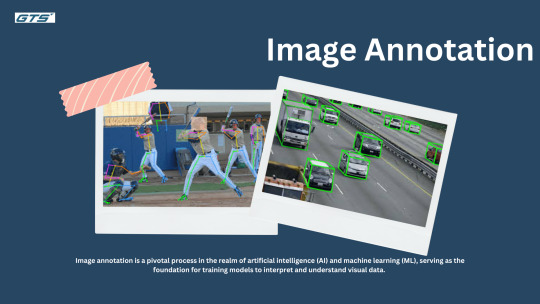
Introduction:
Image Annotation plays a crucial role in the fields of machine learning and artificial intelligence, as it involves the careful labeling of images to train models for the recognition and interpretation of visual information. This essential process empowers machines to detect objects, comprehend scenes, and execute tasks that necessitate visual understanding.
Understanding Image Annotation
Fundamentally, image annotation consists of assigning labels or metadata to images. These labels can represent various components within an image, including objects, boundaries, or particular features. The annotated data acts as a training resource for machine learning models, enabling them to learn and generate accurate predictions for new, previously unseen images.
Key Techniques in Image Annotation
Bounding Box Annotation: This method involves creating rectangular boxes around objects in an image, assisting models in identifying and locating these objects.
Semantic Segmentation: In this approach, each pixel in an image is assigned a class label, facilitating a comprehensive understanding of the image at the pixel level.
Polygon Annotation: For objects with non-standard shapes, polygon annotation provides a means for precise outlining, ensuring that models can accurately learn the shape of the object.
Key Point Annotation: This technique involves marking specific points of interest within an image, such as facial landmarks or joint positions, which is vital for applications like pose estimation.
The applications of image annotation encompass a wide range of fields:
Autonomous Vehicles: Annotated images play a critical role in enabling self-driving cars to identify road signs, pedestrians, and various obstacles, thereby facilitating safe navigation.
Medical Imaging: In the medical field, annotated images are instrumental in the identification and diagnosis of diseases, significantly improving the precision of AI-based diagnostic tools.
Retail: Retail businesses utilize annotated images to enhance product recognition, streamline inventory management, and improve the shopping experience through visual search functionalities.
Applications of Image Annotation

The versatility of image annotation spans numerous industries:
Autonomous Vehicles: High-quality annotated images train models to recognize and respond to various road scenarios, ensuring safety and efficiency in self-driving cars.
Healthcare: In medical imaging, annotated data assists in the detection and diagnosis of diseases by highlighting areas of interest, such as tumors or fractures.
Retail: Image annotation enables automated inventory management and enhances customer experiences through visual search capabilities.
Agriculture: Annotated images help in monitoring crop health, detecting diseases, and managing yields by analyzing aerial imagery.
Challenges in Image Annotation
Despite its significance, image annotation faces several challenges:
Scalability: The manual annotation of extensive datasets is both time-consuming and labor-intensive.
Consistency: Maintaining uniformity in annotations throughout a dataset is essential for ensuring model accuracy.
Complexity: Certain images may contain intricate details that necessitate advanced annotation techniques and specialized knowledge.
Advancements in Annotation Tools
In response to the challenges faced in the field, a variety of annotation tools have been created:
VGG Image Annotator (VIA): This is a straightforward, standalone tool that facilitates manual annotation for images, audio, and video content.
Computer Vision Annotation Tool (CVAT): An open-source, web-based platform specifically designed for the annotation of digital images and videos, it is extensively utilized for tasks such as object detection and image segmentation.
Conclusion
Image annotation is fundamental to the advancement of computer vision applications. As artificial intelligence progresses, the accuracy and quality of annotated data will be essential in developing intelligent systems that can comprehend and interpret the visual environment.
Visit Here: https://gts.ai/services/image-and-video-annotation/
0 notes
Text
A Beginner’s Guide to Crafting Effective Landing Pages
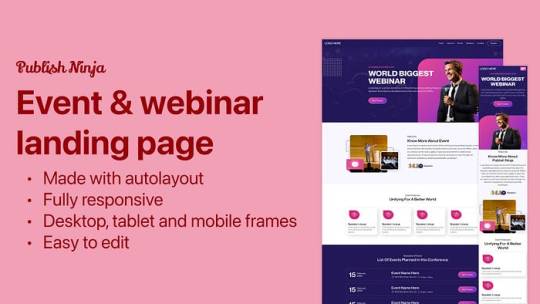
Creating a well-designed landing page is essential for capturing leads, driving conversions, and communicating your brand’s message. This guide will break down the fundamental elements and best practices for crafting high-converting landing pages.
1. Understand the Purpose of a Landing Page
A landing page is a standalone web page designed specifically for marketing or advertising campaigns. Its primary purpose is to convert visitors by getting them to take a specific action, such as signing up for a newsletter, downloading an eBook, or purchasing a product.
2. Define Your Goal
Before you start designing your landing page, identify the objective. Ask yourself what action you want visitors to take. Having a clear goal will help you structure your content and design elements effectively.
3. Craft a Strong Headline
The headline is the first thing visitors see, so make it compelling and relevant. A great headline should:
Grab attention instantly
Communicate the value proposition
Be concise and easy to understand
4. Write Persuasive Copy
Your copy should be clear, concise, and focused on the benefits for the user. Key tips for writing effective copy include:
Highlight the problem your product or service solves
Use bullet points for easy readability
Address user pain points and provide solutions
Include a strong call-to-action (CTA)
5. Design an Eye-Catching Layout
A visually appealing and user-friendly design can make a significant difference in conversion rates. Keep these design principles in mind:
Use a clean and organized layout
Ensure plenty of white space to avoid clutter
Choose a color scheme that aligns with your brand
Use high-quality images or graphics
6. Include a Clear Call-to-Action (CTA)
Your CTA button is one of the most critical elements on the page. Make it stand out and use action-oriented text. Examples include:
“Get Started Now”
“Download Your Free Guide”
“Claim Your Offer Today”
7. Optimize for Mobile Devices
With the increasing number of mobile users, it’s essential to ensure your landing page is fully responsive. Test your design on various screen sizes to provide a seamless experience.
8. Use Social Proof
Building trust is crucial for conversions. Include social proof elements such as:
Testimonials from happy customers
Case studies highlighting success stories
Trust badges and certifications
User reviews and ratings
9. Minimize Distractions
Keep your landing page focused on the primary goal by removing unnecessary elements. Avoid using external links, excessive navigation menus, or unrelated content that may divert visitors’ attention.
10. Create a Sense of Urgency
Encouraging immediate action can boost conversions. Use urgency-inducing techniques such as:
Limited-time offers
Countdown timers
Scarcity messages (“Only a few spots left!”)
11. A/B Test Your Landing Page
Continuous optimization is key to improving your landing page performance. Conduct A/B tests to compare different elements, such as:
Headlines
CTA button colors and text
Images and videos
Copy variations
Analyze the results and implement changes based on user behavior.
12. Ensure Fast Loading Speeds
Page load speed directly impacts user experience and conversions. Optimize images, minimize code, and use reliable hosting to ensure your landing page loads quickly.
13. Add Trust-Building Elements
Security and trust are essential for convincing users to take action. Include elements such as:
SSL certificates
Privacy policy links
Contact information
14. Measure and Analyze Performance
Use analytics tools to track key metrics such as:
Conversion rates
Bounce rates
Time spent on the page
Regularly analyze the data to identify areas for improvement.
Conclusion
Crafting an effective landing page requires a balance of compelling design, persuasive copy, and a user-focused approach. By following these best practices, you can create landing pages that drive conversions and help you achieve your marketing goals.
My Fiver link for : Figma Landing Page Design Service
0 notes
Text
Software Developer vs. Web Developer: Key Differences
In the ever-evolving world of technology, the roles of software developers and web developers have become increasingly important. Although these two professions share similarities, such as writing code and creating applications, they differ significantly in their scope, skill sets, and areas of focus. Understanding the differences between a software developer and a web developer can help individuals decide which career path to pursue, and businesses to make informed hiring decisions.
Scope of Work
One of the primary distinctions between a software developer and a web developer is the scope of their work. A software developer is responsible for creating software applications that can run on various devices such as desktops, laptops, or mobile phones. Software development involves building applications that may or may not require an internet connection to function. These applications could be anything from operating systems, productivity software, mobile apps, or video games. Software developers often work with desktop applications or systems that integrate directly with hardware.
On the other hand, a web developer focuses primarily on building and maintaining websites or web applications that run on web browsers. Web developers ensure that users can interact with websites effectively, and they work with front-end (user interface) and back-end (server-side) technologies to build functional websites. Web developers deal with aspects like site performance, responsiveness, and database integration, and their primary goal is to create engaging and interactive web experiences.
Skill Set and Tools
The technical skills required by software developers and web developers vary significantly, reflecting the different nature of their jobs. Software developers typically work with programming languages like C++, Java, Python, or C#. They may also work with tools like Eclipse, Visual Studio, or specific frameworks suited for developing desktop applications or complex systems. They need strong problem-solving skills, understanding of data structures, algorithms, and may also have to deal with hardware integration in certain cases.
In contrast, web developers specialize in web-specific languages like HTML, CSS, and JavaScript for front-end development, while using PHP, Ruby, Python, or Node.js for back-end development. Web developers also use various frameworks like React, Angular, and Vue.js for front-end and Django, Rails, or Express for back-end. They also work with tools like Git for version control and frameworks like Bootstrap to ensure websites are mobile-responsive.
Development Environment
The development environment for software developers and web developers can also differ. Software development often occurs in standalone environments where developers are working on closed, native applications that don't depend on an internet connection. They may work on local servers or individual machines.
In contrast, web development usually takes place in a networked environment, with developers testing their websites on local servers or online staging environments. They must ensure that websites work across various devices and browsers, keeping in mind factors like load speed and responsive design. The constant need to integrate with web services and ensure smooth performance on the internet adds complexity to a web developer's role.
Career Opportunities and Job Market
Both career paths offer a broad range of job opportunities, but the demand for web developers has grown significantly in recent years due to the rise of digital media, e-commerce, and online services. Companies of all sizes need web developers to maintain their online presence, and the role often offers a faster entry point into the tech industry.
On the other hand, software developers typically have more flexibility to work on a wider range of projects, including developing for desktop applications, embedded systems, or even artificial intelligence. While the demand for software developers is steady, the positions are often more specialized, requiring a deeper understanding of complex algorithms, system architecture, or low-level programming.
Conclusion
While both software developers and web developers share a fundamental understanding of programming and software engineering, they focus on different areas of technology. Software developers work on applications that may or may not be web-based, often focusing on standalone software. Web developers, on the other hand, specialize in creating websites and web applications, ensuring they are functional, user-friendly, and optimized for the web. The differences in their skill sets, the nature of their work, and the environments they operate in are crucial for anyone considering a career in either field. Ultimately, the right path depends on personal interests, whether you prefer building independent applications or contributing to the ever-expanding digital landscape of the web.
0 notes
Text
How to Create Compelling Infographics in PowerPoint
Data To Creative Infographic in PowerPoint: Top Questions Answered
1.How to design infographics in PowerPoint?
To design infographics in PowerPoint, start by selecting a blank slide or a suitable template. Use shapes and icons from the "Insert" tab to create visual elements. Employ SmartArt for structured diagrams like processes or hierarchies. Customize colors and fonts for consistency with your theme. Incorporate data with charts or graphs using the "Insert Chart" option. Add text boxes for brief explanations, ensuring clarity and readability. Utilize alignment tools to keep elements organized. Finally, keep your design simple and focused, ensuring it conveys information effectively without clutter. Save your work in appropriate formats for sharing.
2. What is an infographic presentation?
An infographic presentation is a visual display of information designed to convey complex data quickly and clearly. It combines graphics, charts, and concise text to highlight key points, making it easier for audiences to understand and retain information. Infographics are often used in educational settings, marketing, and business reports to simplify statistics, illustrate concepts, or tell a story visually. By utilizing design elements, colors, and layouts, infographic presentations engage viewers and enhance communication effectiveness.
3. How to make infographics in PPT?
To create infographics in PowerPoint (PPT), start by selecting a blank slide. Use shapes, icons, and images from the "Insert" tab to represent data visually. Utilize SmartArt for organized layouts, and customize colors and fonts to match your theme. Incorporate charts or graphs by going to "Insert" > "Chart." Keep text minimal and use bullet points for clarity. Align elements for a clean look and maintain consistent spacing. Finally, consider using templates for a professional touch, and review your infographic for coherence and visual appeal before presentation.
4. What is the difference between a PPT and an infographic?
A PPT (PowerPoint presentation) is a slide-based format designed for delivering information verbally during presentations, often including text, images, and charts. It allows for sequential storytelling and is typically used in meetings or educational settings. An infographic, on the other hand, is a visual representation of information designed to present complex data clearly and concisely, often for standalone viewing. Infographics prioritize visual appeal and quick understanding, using minimal text to convey messages. While both aim to communicate information effectively, their formats and intended uses differ significantly.
5. How to create infographics?
To create infographics, start by defining your topic and audience. Gather relevant data and information to support your message. Choose a design tool like Canva, Adobe Illustrator, or Piktochart for layout. Select a visually appealing template and organize your content logically, using headings, icons, and charts for clarity. Use a consistent color scheme and font style to enhance readability. Incorporate visual elements to break up text and make complex information digestible. Finally, review for accuracy and clarity before sharing your infographic on platforms suitable for your audience.

Visit: VS Website See: VS Portfolio
0 notes
Text
The Ultimate Guide to Landing Page Development with ServiceZoom

In today’s digital age, the success of any marketing campaign hinges on its ability to convert visitors into customers. One of the most effective tools for achieving this is a well-designed landing page. At ServiceZoom, we specialise in creating high-performing landing pages tailored to your business goals. With our expertise, your campaigns can achieve higher conversion rates and make a lasting impact on your audience.
What Is a Landing Page and Why Is It Important?
A landing page is a standalone web page designed specifically to drive a single, focused objective. Whether it’s capturing leads, promoting a product, or encouraging sign-ups, landing pages are essential for:
Driving Conversions: They are optimised for specific goals, making it easier to guide visitors toward action.
Enhancing User Experience: A clutter-free and purpose-driven design ensures a seamless user journey.
Tracking Campaign Performance: Landing pages provide valuable insights into visitor behaviour and campaign effectiveness.
For more details on how landing pages can transform your marketing efforts, visit ServiceZoom Landing Page Development.
Key Features of a High-Performing Landing Page
At ServiceZoom, we understand what it takes to create landing pages that deliver results. Here are the key features we incorporate into every design:
1. Compelling Headlines
Your headline is the first thing visitors see. It needs to grab attention and clearly convey the value proposition. Our team crafts powerful headlines that instantly resonate with your target audience.
2. Engaging Visuals
Visuals play a critical role in capturing attention and enhancing understanding. Whether it’s high-quality images, videos, or graphics, we ensure every visual element aligns with your brand and message.
3. Clear Call-to-Actions (CTAs)
The CTA is the heart of any landing page. We design clear, persuasive CTAs that guide visitors toward the desired action, whether it’s signing up, making a purchase, or downloading a resource.
4. Mobile Responsiveness
With a significant portion of web traffic coming from mobile devices, it’s essential to have a landing page that performs seamlessly across all screens. Our designs are fully responsive, ensuring an optimal user experience.
5. Fast Loading Speeds
A slow loading landing page can lead to high bounce rates. We optimise every page for speed, ensuring visitors stay engaged and are more likely to convert.
Why Choose ServiceZoom for Landing Page Development?
ServiceZoom combines creativity, technical expertise, and data-driven insights to deliver landing pages that work. Here’s why businesses trust us:
1. Customized Designs
We don’t believe in one-size-fits-all solutions. Each landing page is tailored to your business goals and audience preferences.
2. A/B Testing for Optimization
To maximise performance, we conduct rigorous A/B testing on various elements like CTAs, layouts, and headlines. This ensures your landing page achieves the best possible results.
3. SEO-Friendly Pages
Our landing pages are designed with SEO in mind, helping you attract organic traffic while ensuring compatibility with paid campaigns.
4. Integrated Analytics
Understanding your landing page’s performance is key to continuous improvement. We integrate robust analytics tools to provide actionable insights.
5. Comprehensive Support
From strategy to execution and beyond, our team is with you every step of the way.
Discover more about our landing page development services at ServiceZoom landing page development.
How ServiceZoom’s Landing Pages Drive Results
Here’s how our landing pages help businesses succeed:
Increased Lead Generation: By optimising forms and CTAs, we ensure a steady flow of qualified leads.
Improved ROI on Ads: A well-designed landing page boosts the effectiveness of paid ad campaigns by converting more visitors.
Enhanced Brand Credibility: Professional designs and relevant content build trust and authority.
Higher Engagement Rates: Engaging visuals, interactive elements, and clear messaging keep visitors hooked.
Getting Started with ServiceZoom
Building a successful landing page doesn’t have to be complicated. At ServiceZoom, we make the process easy and efficient. Here’s how you can get started:
Schedule a consultation: Share your goals and campaign details with our experts.
Design and Development: Our team will create a customised landing page tailored to your needs.
Launch and Optimise: Once live, we monitor performance and make data-driven adjustments for continuous improvement.
Conclusion
A well-crafted landing page is a powerful tool for driving conversions and achieving your marketing objectives. With ServiceZoom Landing Page Development, you get access to industry-leading expertise and cutting-edge tools to create landing pages that deliver measurable results.
Take your campaigns to the next level with ServiceZoom. Visit ServiceZoom today and let us help you create landing pages that leave a lasting impression.
#LandingPageDevelopment#ServiceZoom#WebDevelopmentTips#LandingPageDesign#WebDesignInspiration#DigitalMarketingStrategy#WebOptimization#ConversionOptimization#WebsiteTraffic#MarketingGuide#LandingPageExperts#WebDevelopmentTools#OnlineBusinessGrowth#LeadGenerationTips#WebsiteDesignTrends#SEOAndWebDesign#LandingPageTips#ServiceZoomGuide#WebDevelopment2025#UserExperienceDesign
0 notes
Text
Mastering the Art of Low-Code Development: Mendix Intermediate Course at Mayon Academy
In today's fast-paced world of software development, the demand for low-code solutions has never been higher. Low-code platforms like Mendix enable businesses to innovate quickly, reduce development time, and adapt to ever-changing market needs. If you've already taken your first steps into the world of low-code with the Mendix Rapid Developer Certification Course, it's time to elevate your skills and deepen your understanding with the Mendix Intermediate Developer Course at Mayon Academy.
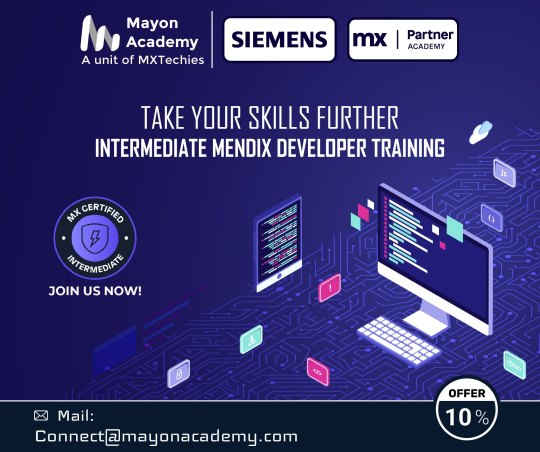
Why Choose the Mendix Intermediate Course?
The Mendix Intermediate Developer Course is designed for professionals who want to go beyond the basics and gain expertise in building scalable, efficient, and user-friendly applications. This course bridges the gap between beginner and advanced skills, providing the perfect foundation for tackling complex development challenges.
At Mayon Academy, we pride ourselves on delivering a comprehensive learning experience tailored to industry needs. Whether you’re looking to build robust data models, design dynamic microflows, or enhance your app’s user experience, this course equips you with the tools to succeed.
What You’ll Learn
Advanced Data Modeling: Master the art of creating and managing complex data structures to ensure your applications are both scalable and efficient.
Microflows Mastery: Dive deeper into automation and logic design to make your apps smarter and more intuitive.
UI/UX Enhancements: Learn how to create visually appealing and user-friendly interfaces tailored to your target audience.
Integration Capabilities: Understand how to seamlessly integrate third-party systems to expand your app's functionality.
By the end of the course, you'll have the confidence and expertise to design, develop, and deploy intermediate-level Mendix applications that meet real-world business requirements.
A Pathway to Advanced Certification
The Mendix Intermediate Developer Course isn’t just a standalone program; it’s a stepping stone to the Mendix Advanced Developer Certification Course. Completing the intermediate course sets you on a clear path to becoming an expert in Mendix, ready to tackle even the most complex enterprise-grade projects.
Why Mayon Academy?
As the leading Mendix training provider in India, Mayon Academy offers unparalleled expertise and hands-on learning experiences. Our instructors bring real-world insights and practical knowledge, ensuring you’re not just learning concepts but applying them effectively.
If you’re still exploring your options, you can revisit the foundational Mendix Rapid Developer Certification Course to strengthen your basics before taking on this intermediate challenge.
Take the Next Step
Ready to transform your low-code development journey? Enroll in the Mendix Intermediate Developer Certification Course today and unlock new opportunities in the world of low-code application development.
Stay ahead of the curve, innovate faster, and build smarter with Mayon Academy.
0 notes
Text
Mastering Semantic Search: How to Optimize for User Intent

It's no longer about stuffing keywords into content; it's about understanding and aligning with user intent. In this blog, we’ll delve into advanced strategies for optimizing your content and website for semantic search, providing actionable tips to keep you ahead in 2025.
What is Semantic Search?
Semantic search is the process by which search engines understand the context and intent behind a query, rather than focusing solely on matching keywords. Powered by AI and machine learning, semantic search delivers more accurate, context-aware results, considering factors like:
Searcher context: Location, device, past behavior.
Entity recognition: Identifying people, places, and concepts.
Natural language understanding: Interpreting synonyms, queries, and questions.
This evolution has shifted the focus from individual keywords to clusters of related concepts.
Why Optimizing for User Intent Matters
User intent—the goal behind a search query—is at the heart of semantic search. By aligning your content with the four key types of user intent, you can:
Informational: Provide answers to “How”, “What”, and “Why” questions.
Navigational: Help users find specific websites or brands.
Transactional: Support purchase decisions.
Commercial investigation: Offer in-depth comparisons and insights.
The better your content meets these intents, the higher your chances of ranking.
Advanced Strategies for Semantic Search Optimization
1. Implement Topic Clustering
Move beyond standalone keywords and structure your content around topic clusters. This involves creating:
Pillar pages: Comprehensive content pieces covering core topics.
Cluster content: Supporting articles that delve into specific subtopics and link back to the pillar page.
This approach signals to search engines that your site is an authority on a subject, improving relevance and rankings.
2. Leverage Schema Markup
Schema markup helps search engines understand your content's context. Use structured data to enhance rich snippets, such as:
Product reviews and ratings.
FAQs and how-to guides.
Event details.
Adding schema boosts visibility and click-through rates (CTR) by making your results stand out.
3. Focus on Natural Language Processing (NLP)
Craft content that mirrors how people naturally search and speak. To do this:
Use conversational tones and question-answer formats.
Target long-tail keywords and questions.
Analyze People Also Ask (PAA) boxes for trending queries.
4. Utilize AI-Powered Tools
AI-driven tools like Google’s Natural Language API or MarketMuse can:
Analyze your content’s topical relevance.
Identify gaps in your keyword and entity coverage.
Suggest semantic improvements.
5. Optimize for Voice Search
With voice search on the rise, focus on:
Answering common voice queries succinctly.
Optimizing for local search terms (e.g., “near me” queries).
Using structured data to ensure compatibility with voice assistants.
6. Enhance E-A-T Signals
Google emphasizes expertise, authoritativeness, and trustworthiness (E-A-T) in rankings. To strengthen E-A-T:
Showcase credentials for authors.
Earn backlinks from reputable sites.
Regularly update content to maintain accuracy and relevance.
7. Invest in Visual Search Optimization
With advancements in image recognition, optimizing for visual search can give you an edge:
Use descriptive alt texts and filenames.
Add structured data for images.
Optimize image load speeds.
8. Track Search Intent Changes
User intent evolves. Regularly review your analytics to identify shifts in search behavior. Use tools like SEMrush and Ahrefs to monitor trending queries and adapt your content strategy accordingly.
Measuring Success
Evaluate the effectiveness of your semantic search optimization by:
Monitoring CTR and bounce rates.
Tracking keyword rankings for topic clusters.
Measuring engagement metrics like time on page and social shares.
Conclusion
Mastering semantic search in 2025 requires a forward-thinking approach. By focusing on user intent, leveraging AI tools, and optimizing for natural language and visual search, you can stay ahead in the ever-evolving SEO landscape. Embrace these strategies, and you’ll not only improve rankings but also create meaningful connections with your audience.
0 notes
Text
Exploring the Drone Communication Market Size and Key Growth Drivers

The Drone Communication Market is undergoing a transformation, projected to surge from USD 2.58 billion in 2024 to USD 14.49 billion by 2028, registering a robust CAGR of 21.2%. This remarkable growth reflects the increasing reliance on drones for military, commercial, and civilian applications, driven by technological advancements like 5G, SATCOM, and mesh networking. From enhancing real-time data exchange to enabling autonomous operations, drone communication technologies are setting the stage for a future where drones become indispensable to various industries.
Understanding the Drone Communication Market Landscape
Drone communication systems are critical for enabling real-time data exchange, secure command, and seamless control. These systems empower drones to perform tasks autonomously with minimal human intervention. The market is witnessing substantial investments in cutting-edge innovations, such as AI-based communication protocols, hybrid networks, and modular designs, which enhance efficiency and connectivity.
As drones transition from niche tools to essential assets, their communication systems have become pivotal for operations in military intelligence, urban air mobility, autonomous deliveries, and disaster management. This evolution underscores the potential of drone communication technologies to revolutionize industries and reshape the global UAV landscape.
Download PDF Brochure: https://www.marketsandmarkets.com/pdfdownloadNew.asp?id=220457835
Key Drivers of the Drone Communication Market
Advancements in 5G and IoT Integration
The integration of 5G and IoT is revolutionizing drone communication by enabling ultra-low latency, faster data transfer speeds, and massive connectivity. These technologies unlock unprecedented capabilities, such as real-time data transmission, high-definition video streaming, and enhanced reliability in autonomous navigation. This synergy is particularly beneficial for applications like Beyond Visual Line of Sight (BVLOS) operations, urban air mobility, and large-scale drone fleets.
By leveraging 5G networks, drones can operate with minimal interference and extended coverage. IoT integration further expands possibilities by establishing vast sensor networks for real-time monitoring and analytics, ensuring smooth coordination with ground control systems. These advancements eliminate operational bottlenecks, paving the way for innovative use cases and scalability in drone operations.
Growing Demand for Hybrid Communication Models
Hybrid communication models are gaining traction as they offer flexibility and resilience. By combining SATCOM, 5G, and RF technologies, hybrid systems ensure uninterrupted connectivity, even in challenging environments. This adaptability is crucial for applications like disaster response and military operations, where reliable communication is paramount.
Hybrid models allow drones to switch dynamically between communication modes based on operational needs, enhancing efficiency and operational range. This approach addresses limitations faced by standalone communication technologies, making hybrid models a key growth opportunity in the drone communication market.
Restraints Hindering Market Growth
Despite its promising outlook, the drone communication market faces challenges that could slow its growth trajectory. The high costs associated with advanced communication systems, including SATCOM modules and encrypted transceivers, pose a significant barrier. These components are essential for secure, long-range operations but often require substantial investment, making them less accessible to small- and medium-sized enterprises.
Furthermore, the adoption of advanced communication systems frequently necessitates infrastructure upgrades, increasing the overall cost of ownership. This financial burden can deter potential users, particularly in sectors like agriculture and logistics, where cost-efficiency is critical.
Challenges in Data Security and Cyber Threats
The reliance on real-time communication makes drones vulnerable to cyber threats such as hacking, jamming, and spoofing. These risks can compromise mission-critical operations, particularly in high-sensitivity applications like military surveillance and disaster response. The lack of standardized security protocols across regions and industries exacerbates this challenge, increasing inconsistencies in protecting drone communication systems.
To address these issues, significant investments in encryption technologies and cybersecurity solutions are required. However, implementing robust security measures while maintaining low latency and high efficiency remains a complex technical challenge. Overcoming these hurdles will require collaboration between industry stakeholders, regulatory bodies, and cybersecurity experts.
Ask for Sample Report: https://www.marketsandmarkets.com/requestsampleNew.asp?id=220457835
Opportunities in the Drone Communication Market
The adoption of hybrid communication models and advancements in AI-based communication protocols present exciting opportunities. Companies investing in these technologies can develop resilient and efficient communication systems, enabling drones to operate seamlessly across diverse environments.
Additionally, the growing demand for autonomous drones and BVLOS operations creates new avenues for innovation. With the increasing adoption of UAVs in applications like infrastructure inspection, urban deliveries, and agricultural monitoring, the drone communication market is poised for significant expansion.
Regional Insights and Market Segmentation
The North American region is expected to lead the drone communication market during the forecast period, driven by extensive 5G infrastructure and strong investment in UAV technologies. Europe and Asia Pacific are also emerging as key markets, supported by advancements in communication technologies and increasing adoption of drones across industries.
Market segmentation reveals that the demand for advanced communication solutions is highest in military and commercial applications. As the adoption of drones expands, the aftermarket segment is projected to grow significantly, driven by maintenance, repair, and upgrades.
The Path Forward: Innovations and Industry Collaboration
The future of the drone communication market lies in continued innovation and collaboration among industry stakeholders. Advancements in hybrid communication models, AI integration, and cybersecurity solutions will be crucial for overcoming current challenges and unlocking new possibilities.
As industries increasingly adopt drones for various applications, the demand for efficient, secure, and reliable communication systems will only grow. By investing in next-generation technologies and fostering partnerships, companies can position themselves at the forefront of this rapidly evolving market.
To Gain Deeper Insights Into This Dynamic Market, Speak to Our Analyst Here: https://www.marketsandmarkets.com/speaktoanalystNew.asp?id=220457835
FAQs
1. What is the projected growth rate of the Drone Communication Market?
The Drone Communication Market is projected to grow at a CAGR of 21.2% from 2024 to 2028, reaching USD 14.49 billion by the end of the forecast period.
2. What are the key drivers of the market?
Key drivers include advancements in 5G and IoT integration, the adoption of hybrid communication models, and the growing demand for autonomous UAV operations.
3. What challenges does the market face?
The market faces challenges such as high costs of advanced communication systems, data security risks, and cyber threats.
4. Which regions are leading the market?
North America is expected to lead the market, followed by Europe and Asia Pacific, driven by advancements in communication technologies and increasing drone adoption.
5. How can companies address data security concerns?
Companies can address data security concerns by investing in encryption technologies, developing standardized security protocols, and collaborating with cybersecurity experts.
This comprehensive overview of the Drone Communication Market highlights its growth potential, key drivers, challenges, and opportunities. With continuous innovation and strategic investments, the market is poised to revolutionize industries and redefine the role of drones in the modern world.
#drone communication market#5g#iot#satcom#uav connectivity#drone communication trends#drone market growth
0 notes
Text
SEO and User Experience: How They Work Together to Boost Rankings
In today’s competitive digital landscape, both SEO and user experience (UX) play pivotal roles in determining the success of your website. Partnering with the Best Search Engine Optimization agency in hyderabad, such as hyderabad.osumare.com, can help you strike the perfect balance between these elements to elevate your website rankings. While SEO focuses on optimizing content for search engines, UX ensures visitors have a seamless and engaging experience when they land on your site. Together, they create a powerful synergy that drives traffic and enhances user satisfaction.
Understanding the Relationship Between SEO and UX
Search engines like Google prioritize delivering the best possible experience to their users. They do so by favoring websites that are not only rich in relevant content but also provide excellent usability. Let’s break down how SEO and UX complement each other:
Page Load Speed Fast-loading pages rank higher in search engines and provide a better user experience. A slow website frustrates users and increases bounce rates, which negatively impacts SEO rankings.
Mobile Responsiveness With mobile-first indexing, Google gives preference to mobile-friendly websites. Ensuring your site is responsive to all devices is critical for both SEO and UX.
Navigation and Site Structure A well-organized website helps users find information quickly and allows search engine crawlers to index your site efficiently. Intuitive navigation benefits both your audience and your SEO efforts.
Content Quality and Relevance High-quality, relevant content satisfies user intent and keeps visitors engaged longer. This not only improves UX but also sends positive signals to search engines, improving rankings.
How SEO Agencies Enhance UX
The Best Search Engine Optimization agency in Hyderabad, like hyderabad.osumare.com, implements strategies that align SEO with UX principles. Their approach typically includes:
Conducting in-depth keyword research to create content that resonates with the target audience.
Optimizing meta descriptions and titles to attract clicks without misleading users.
Ensuring website design is intuitive, visually appealing, and functional.
Regularly analyzing user behavior to make data-driven improvements to the website.
The Role of Analytics in Merging SEO and UX
To effectively integrate SEO and UX, monitoring metrics like bounce rate, dwell time, and click-through rate is essential. These indicators reveal how users interact with your site and whether your SEO strategies align with their expectations.
Conclusion
SEO and user experience are not standalone strategies—they are two sides of the same coin. When harmonized, they can transform your website into a powerful tool that drives traffic, boosts engagement, and improves search engine rankings. By partnering with the Best Search Engine Optimization agency in Hyderabad, such as hyderabad.osumare.com, you can ensure that both aspects are optimized for maximum impact.
#Best Search Engine Optimization agency in hyderabad#Top Search Engine Optimization agency in hyderabad#Best Search Engine Optimization agency of hyderabad
0 notes
Text
Exploring the Best Kanban Tools Beyond Trello: Spotlight on TroopMessenger and TroopTodo
Kanban boards are a go-to tool for visualizing workflows and managing tasks efficiently. Trello, a household name in this domain, has been a pioneer in bringing Kanban-style task management to the mainstream. But what if you're looking for alternatives? Let’s explore some remarkable Kanban tools and see why TroopMessenger and its integrated solutions, such as TroopTodo, stand out as exceptional choices.

Top Kanban Tools Besides Trello
Asana Asana’s Kanban boards offer a highly flexible way to organize your projects. Its ability to integrate with a variety of apps makes it a great choice for teams needing advanced task management capabilities.
Monday.com Monday.com combines Kanban boards with timeline views, automations, and a user-friendly interface. It’s ideal for teams that want a blend of to do list and high-level planning.
ClickUp ClickUp’s customizability and wide range of features make it a strong contender. Its Kanban boards are just one part of an extensive task management ecosystem.
Jira Built with developers in mind, Jira’s Kanban boards are perfect for Agile and Scrum workflows, offering deep functionality for tech teams.
TroopMessenger Task Management TroopMessenger provides an intuitive Kanban board as part of its comprehensive team collaboration suite. Unlike standalone tools, TroopMessenger integrates task management seamlessly with communication features like chat, video conferencing, and file sharing.
Why TroopTodo Outshines Todoist
When it comes to the best to do app, TroopTodo emerges as a game-changer. While Todoist has been a long-standing favorite for individuals and small teams, TroopTodo offers unique advantages that cater to modern team needs:
Team-Centric Features: TroopTodo is built for collaboration, enabling teams to assign, track, and prioritize tasks effortlessly.
Integrated Communication: Unlike Todoist, TroopTodo benefits from TroopMessenger’s robust communication tools, allowing for instant context sharing without switching apps.
Customizable Workflows: TroopTodo’s flexibility in creating workflows ensures that it fits a variety of project types and team structures.
Enhanced Security: With enterprise-grade encryption, TroopTodo ensures that your task data remains safe, a feature where Todoist lags behind.
The TroopMessenger Edge
TroopMessenger is more than a todo app; it’s a comprehensive collaboration ecosystem. Here’s why it stands out:
Versatile Features: From instant messaging and video conferencing to screen sharing and file sharing, TroopMessenger packs all the tools teams need to collaborate efficiently.
Quality and Reliability: TroopMessenger offers high uptime and seamless performance, ensuring teams can stay connected without disruptions.
Integrated Task Management: The task manager within TroopMessenger allows for real-time collaboration on Kanban boards, bridging the gap between task planning and execution.
Affordable and Scalable: TroopMessenger’s pricing structure accommodates businesses of all sizes, making it a cost-effective alternative to multiple standalone tools.
Final Thoughts
If you’re on the lookout for a todo app that does more than just organize tasks, TroopMessenger and its TroopTodo feature deserve your attention. Their combination of robust task management, seamless communication, and top-notch quality services make them ideal for teams aiming to elevate their productivity. Whether you’re a small business or a large enterprise, the comprehensive suite offered by TroopMessenger can revolutionize the way you work.
#To Do#Task Management#todo app#best to do app#todo#todoist#to do#to do list#task manager#to do list app#todo list
1 note
·
View note
Text
OTT App Development: Revolutionizing Entertainment with ideyaLabs

The entertainment landscape is changing. Traditional cable TV is giving way to Over-The-Top (OTT) streaming services. OTT platforms allow users to watch their favorite shows and movies online, bypassing traditional distribution networks. ideyaLabs stands out as a leader in OTT app development, helping businesses create seamless streaming experiences.
What is OTT App Development?
OTT app development involves creating apps that deliver video content over the internet. These apps work across various devices: smartphones, tablets, smart TVs, and gaming consoles. The convenience and flexibility of OTT apps make them a popular choice for users worldwide.
Why Choose ideyaLabs?
Expertise in OTT App Development: ideyaLabs brings years of experience in OTT app development. Our team knows the ins and outs of streaming technology, ensuring your app performs flawlessly. From design to deployment, we handle every aspect of development.
Cutting-Edge Technology: We use the latest technology to build robust and scalable OTT apps. Our developers are proficient in using advanced tools and frameworks, delivering top-quality apps that meet industry standards.
Custom Solutions: Every business has unique needs. ideyaLabs offers custom OTT app development solutions tailored to your requirements. Whether you need a standalone app or an integrated platform, we’ve got you covered.
Features of Our OTT Apps
Seamless Streaming: Enjoy uninterrupted streaming with our highly optimized OTT apps. Our apps offer smooth playback with little to no buffering, even on low-bandwidth networks.
Multi-Platform Support: Our OTT apps work seamlessly across various devices and operating systems. Users can access your content from their preferred devices, enhancing their viewing experience.
User-Friendly Interface: A user-friendly interface is crucial for an enjoyable viewing experience. Our designers create intuitive and easy-to-navigate interfaces, ensuring users can find and watch their favorite content effortlessly.
High-Quality Video: Provide your audience with high-definition video quality. Our OTT apps support HD and 4K streaming, delivering crisp and clear visuals.
Personalized Recommendations: Enhance user engagement with personalized content recommendations. Our OTT apps analyze user preferences and viewing habits to suggest relevant content.
Secure & Scalable: Security is a top priority. We implement robust security measures to protect your content from unauthorized access and piracy. Our OTT apps are scalable, allowing you to expand your content library without compromising performance.
Benefits of OTT App Development
Global Reach: OTT platforms enable you to reach a global audience. With internet access, users from different parts of the world can access your content, expanding your market reach.
Monetization Opportunities: Various monetization options come with OTT apps. Subscription-based models, pay-per-view, and ad-supported content are a few ways to generate revenue.
Data Analytics: OTT apps provide valuable insights into user behavior and preferences. Use this data to refine your content strategy and improve user engagement.
Brand Loyalty: Offer exclusive content and special features to keep your audience engaged. Build brand loyalty with a dedicated OTT platform that caters to your audience's preferences and needs.
ideyaLabs Development Process
Requirement Analysis: ideyaLabs begins with a thorough analysis of your requirements. We understand your goals and target audience to create a comprehensive development plan.
Design & Development: Our design team crafts a visually appealing and intuitive interface. The development team then brings the design to life, ensuring the app functions flawlessly.
Testing & Quality Assurance: Rigorous testing is essential to ensure a flawless user experience. We conduct extensive testing to identify and fix any issues before launch.
Deployment & Maintenance: We handle the deployment process, ensuring your app is available to users without any hiccups. Our maintenance services ensure your app remains updated and secure.
Our Success Stories
Case Study - StreamFlix: ideyaLabs developed a successful OTT app for StreamFlix, a popular streaming service. The app boasts a user-friendly interface and offers seamless streaming across multiple devices. StreamFlix saw a significant increase in user engagement and subscriptions after launching their OTT app.
Case Study - CinemaBox: CinemaBox partnered with ideyaLabs to create a feature-rich OTT app. The app includes personalized recommendations, high-quality video streaming, and robust security measures. CinemaBox experienced a boost in user retention and revenue with their new OTT platform.
The ideyaLabs Advantage
Dedicated Team: Our team of experienced developers, designers, and analysts work together to deliver outstanding OTT solutions. We prioritize your success and work tirelessly to achieve your goals.
Innovation Driven: ideyaLabs stays ahead of industry trends, constantly exploring new technologies and solutions. We innovate to provide you with cutting-edge OTT apps that stand out in the market.
Client-Centric Approach: Your satisfaction is our priority. We maintain open communication throughout the development process, ensuring your feedback is incorporated and your vision is realized.
Post-Launch Support: Our commitment doesn’t end with the app launch. We provide ongoing support and maintenance to ensure your OTT app remains up-to-date and performs optimally.
Embrace the OTT Revolution
Don't miss out on the OTT revolution. Partner with ideyaLabs for top-notch OTT app development services. Create a compelling streaming experience and captivate your audience. Unlock new revenue streams and expand your global reach.
Contact ideyaLabs today to start your OTT app development journey. Our expertise and dedication will help you achieve success in the competitive world of OTT streaming. Get in touch with our team and discover the endless possibilities of OTT technology. Let ideyaLabs transform your vision into reality with cutting-edge OTT solutions.
Join the OTT Future with ideyaLabs: Take the leap into the future of entertainment with ideyaLabs. Our OTT app development services will propel your business forward, keeping you ahead of competitors. Experience the ideyaLabs difference and lead the way in OTT streaming.
0 notes
Text
The Graphic Processing Unit Market: Powering the Future

The Graphic Processing Unit (GPU) market has evolved from serving as a specialized tool for rendering visuals to becoming a cornerstone of modern computing. Once primarily associated with gaming, GPUs now drive innovations across diverse industries, from artificial intelligence (AI) to autonomous vehicles and cryptocurrency mining. This evolution underscores the GPU's pivotal role in powering advanced computational tasks and shaping the future of technology.
Expanding Applications: Beyond Gaming
Initially designed to handle the complex rendering of images, GPUs have become essential for numerous high-performance computing tasks. Their parallel processing capabilities make them ideal for applications such as:
Artificial Intelligence and Machine Learning: GPUs excel in processing vast datasets, enabling faster training of machine learning models and more efficient AI computations.
Autonomous Vehicles: In self-driving technology, GPUs process real-time data from cameras, sensors, and lidar systems to make split-second decisions.
Cryptocurrency Mining: GPUs are indispensable in mining cryptocurrencies like Bitcoin and Ethereum, as they handle the complex algorithms required for blockchain validation.
Healthcare and Biotechnology: GPUs facilitate advancements in medical imaging and drug discovery by accelerating simulations and data analysis.
Checkout the Details in this Report
Market Drivers: What’s Fueling the Growth?
Proliferation of AI and Big Data: The increasing adoption of AI technologies in sectors like healthcare, finance, and entertainment is driving demand for GPUs capable of handling massive computational workloads.
Gaming Industry Expansion: The global gaming market continues to grow, with GPUs serving as the backbone of high-performance gaming systems and e-sports.
Cloud Computing and Data Centers: Cloud service providers rely on GPUs for their ability to process vast amounts of data efficiently, supporting virtual desktops, AI training, and rendering services.
Advancements in Graphics Technology: Innovations such as ray tracing and 4K/8K resolution gaming further push the demand for cutting-edge GPUs.
Key Market Segments
By Type
Discrete GPUs: Standalone units designed for high-performance tasks, commonly used in gaming PCs and workstations.
Integrated GPUs: Built into processors, offering energy-efficient solutions for everyday computing needs.
By Application
Gaming: Continues to dominate, with gamers seeking realistic graphics and seamless performance.
Professional Visualization: Used in industries like architecture, animation, and video production for rendering and simulation.
Data Science: Crucial for handling analytics, AI model training, and real-time data processing.
Regional Insights
North America: Leads the market, driven by strong demand for gaming GPUs and advancements in AI and cloud computing.
Asia-Pacific: The fastest-growing region, fueled by rising disposable incomes, expanding gaming communities, and large-scale industrial adoption of AI technologies.
Europe: Witnessing steady growth due to increasing investments in technology infrastructure and gaming culture.
Rest of the World: Emerging markets are gaining traction with increasing digitalization and tech adoption.
Challenges Facing the GPU Market
Supply Chain Disruptions: The global semiconductor shortage has created bottlenecks in GPU manufacturing and supply.
High Costs: Advanced GPUs often come with hefty price tags, limiting accessibility for some consumers and businesses.
Power Consumption: As GPUs become more powerful, managing their energy consumption and heat generation poses a challenge.
Future Trends in the GPU Market
AI-Optimized GPUs: Manufacturers are focusing on GPUs designed specifically for AI and machine learning tasks, making them more efficient and capable.
Advancements in Cloud Gaming: As cloud gaming services grow, GPUs tailored for cloud environments are becoming increasingly important.
Energy-Efficient Designs: Efforts are underway to develop GPUs with lower energy footprints to align with global sustainability goals.
Integration with CPUs: The convergence of GPU and CPU capabilities is leading to more versatile computing solutions.
Conclusion
The GPU market is not just expanding—it’s transforming the technology landscape. GPUs are at the forefront of innovation, from powering immersive gaming experiences to enabling groundbreaking AI applications. With continuous advancements in technology and growing adoption across industries, the future of the GPU market looks brighter than ever, promising to drive the next wave of technological evolution.
Browse More:
Food Traceability Industry Advancements
Healthcare IT Integration Market Overview
1 note
·
View note
Text
Immersive Technologies: Revolutionizing the Future of Experiences

Immersive technologies are transforming the way we interact with the world by blurring the lines between physical and digital experiences. From virtual reality (VR) to augmented reality (AR) and mixed reality (MR), these technologies are reshaping industries, enabling innovative solutions, and enhancing customer engagement. This article explores the exciting realm of immersive technologies, their applications, benefits, and future potential.
What Are Immersive Technologies?
Immersive technologies refer to advanced systems that create or enhance real-world environments using digital tools. They immerse users in a simulated or augmented experience, providing them with a sense of presence. The three primary types are:
Virtual Reality (VR): Creates fully immersive, computer-generated environments.
Augmented Reality (AR): Adds digital elements to the real-world environment through devices like smartphones or AR glasses.
Mixed Reality (MR): Combines elements of VR and AR, allowing interaction between real and virtual worlds.
Applications of Immersive Technologies Across Industries
Healthcare: Immersive technologies are revolutionizing medical training, patient care, and therapy. For example, VR is used to train surgeons with realistic simulations, while AR aids in precise surgeries by overlaying critical data onto the patient’s body.
Education and Training: Immersive classrooms and VR-based training modules enhance learning experiences. Students can explore historical landmarks, dissect virtual organisms, or undergo industry-specific simulations for hands-on learning.
Entertainment and Gaming: VR and AR have transformed gaming into a highly interactive experience. Platforms like Oculus and PlayStation VR deliver games that feel incredibly lifelike.
Retail and E-commerce: AR allows customers to visualize products in their real environment. For instance, IKEA’s AR app lets users place virtual furniture in their homes before purchasing.
Real Estate and Architecture: Immersive walkthroughs of properties or architectural designs enable clients to visualize projects before they are built.
Manufacturing and Design: Mixed reality is utilized for prototyping, quality control, and troubleshooting. It speeds up processes and reduces errors.
Benefits of Immersive Technologies
Enhanced Engagement: Immersive experiences captivate users, fostering higher engagement and retention rates.
Cost Efficiency: Training through VR simulations reduces the need for physical resources, saving costs while improving outcomes.
Improved Decision-Making: Realistic simulations and visualizations enable better-informed decisions, especially in industries like real estate, healthcare, and manufacturing.
Accessibility: These technologies make complex tasks easier to understand and perform, democratizing access to knowledge and experiences.
Challenges of Immersive Technologies
While the benefits are immense, there are some challenges to address:
High Costs: Initial investment in immersive technology hardware and software can be significant.
Technical Limitations: Limited hardware capabilities and bandwidth constraints can impact performance.
User Adaptation: Not all users are comfortable with or accustomed to immersive technologies, which may slow adoption.
Privacy and Security: Collecting data in virtual environments raises concerns about user privacy and data protection.
Future Trends in Immersive Technologies
Advancements in Hardware: Lighter and more affordable devices like AR glasses and standalone VR headsets will make these technologies more accessible.
5G Integration: Faster internet speeds will enhance real-time immersive experiences, particularly for AR and MR applications.
AI and Immersive Tech: Artificial intelligence will play a key role in making virtual environments more intelligent and interactive.
Immersive Workspaces: The rise of virtual offices and collaboration platforms will transform the way teams work globally.
Mainstream Adoption: As immersive technologies become more affordable, they will become integral to everyday life, from shopping to healthcare.
How Businesses Can Leverage Immersive Technologies
Enhancing Customer Experiences: Businesses can use AR apps or VR showrooms to offer customers a unique and engaging experience.
Training and Development: Industries like aviation and healthcare can invest in VR simulations for safer and more effective training.
Marketing Campaigns: Brands can use AR filters on social media or VR-based ad campaigns to stand out from competitors.
Remote Collaboration: Immersive workspaces enable teams to collaborate effectively across different locations.
Prototyping and Product Design: Companies can leverage MR for rapid prototyping, reducing costs and development time.
Real-World Examples of Immersive Technologies
Retail: Sephora uses AR to let customers try on makeup virtually.
Healthcare: AccuVein employs AR for vein visualization, improving the success of first-stick attempts.
Entertainment: Pokémon GO's AR-based gameplay became a global sensation.
Automotive: Volvo uses VR for car design and customer test drives.
Conclusion
Immersive technologies are no longer just futuristic concepts; they are becoming an integral part of our daily lives. From revolutionizing industries to creating unparalleled experiences, the possibilities are endless. By adopting immersive technologies, businesses can stay ahead of the curve and deliver innovative solutions that cater to modern-day needs.
As we move forward, immersive technologies will continue to shape how we interact with the world, unlocking new opportunities for growth and innovation.
#Immersive Technologies#Virtual Reality#Augmented Reality#Mixed Reality#Future of Immersive Technology#Applications of VR and AR#Benefits of Immersive Technologies#Emerging Technology Trends 2025#VR and AR in Healthcare#Immersive Customer Experiences#tagbin#artificial intelligence#technology#writers on tumblr
0 notes